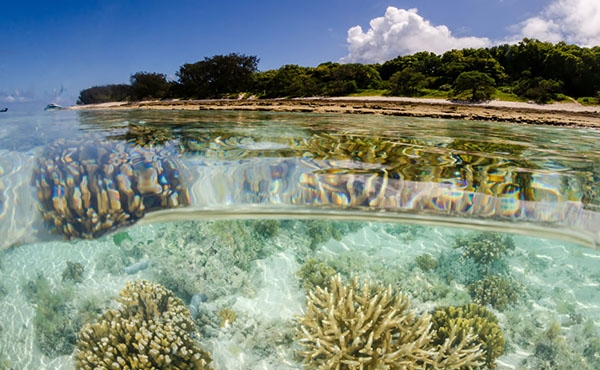49.
Roff, G., Brown, C.J., Priest, M.A. and Mumby, P.J. 2018, Decline of coastal apex shark populations over the past half century, Communications Biology 1(1): 223.
349.
Desbiens, A.A., Mumby, P.J., Dworjanyn, S., Plagányi, ÉE., Uthicke, S., et al. 2023, Novel rubble-dwelling predators of herbivorous juvenile crown-of-thorns starfish (Acanthaster sp.), Coral Reefs 42: 579-591.
374.
McMahon, S.J., Munday, P.L. and Donelson, J.M. 2023, Energy use, growth and survival of coral reef snapper larvae reared at elevated temperatures, Coral Reefs 42: 31-42.
394.
Roff, G., Doropoulos, C., Rogers, A., Bozec, Y., Krueck, N.C., et al. 2016, The ecological role of sharks on coral reefs, Trends in Ecology and Evolution 31(5): 395-407.
396.
Desbiens, A.A., Roff, G., Robbins, W.D., Taylor, B.M., Castro‐Sanguino, C., et al. 2021, Revisiting the paradigm of shark‐driven trophic cascades in coral reef ecosystems, Ecology 102(4): e03303.
400.
Lester, E.K., Langlois, T.J., Simpson, S.D., McCormick, M.I. and Meekan, M.G. 2021, Reef‐wide evidence that the presence of sharks modifies behaviors of teleost mesopredators, Ecosphere 12(2): e03301.
407.
Hoel, K., Chin, A. and Lau, J. 2022, Clashing conservation values: the social complexities of shark depredation, Biological Conservation 272: 109658.
772.
Wolfe, K., Anthony, K., Babcock, R.C., Bay, L., Bourne, D., et al. 2019, Recommendations to maintain functioning of the Great Barrier Reef, Reef and Rainforest Research Centre Limited, Cairns.
823.
Ceccarelli, D. and Ayling, T. 2010, Role, importance and vulnerability of top predators on the Great Barrier Reef: a review, Great Barrier Reef Marine Park Authority, Townsville.
824.
Stier, A.C., Stallings, C.D., Samhouri, J.F., Albins, M.A. and Almany, G.R. 2017, Biodiversity effects of the predation gauntlet, Coral Reefs 36: 601-606.
826.
Emslie, M.J., Cappo, M., Currey-Randall, L.M., Gonzalez-Rivero, M., Johns, K., et al. 2019, Status and trends of reef fish and benthic assemblages of the far northern Great Barrier Reef, Townsville.
827.
Cowan, Z., Ling, S.D., Caballes, C.F., Dworjanyn, S.A. and Pratchett, M.S. 2020, Crown-of-thorns starfish larvae are vulnerable to predation even in the presence of alternative prey, Coral Reefs 39: 293-303.
825.
Ahti, P.A., Kuparinen, A. and Uusi-Heikkilä, S. 2020, Size does matter—the eco-evolutionary effects of changing body size in fish, Environmental Reviews 28(3): 311-324.
828.
Kroon, F.J., Barneche, D.R. and Emslie, M.J. 2021, Fish predators control outbreaks of crown-of-thorns starfish, Nature Communications 12(1): 6986.
829.
Balu, V., Messmer, V., Logan, M., Hayashida-Boyles, A.L. and Uthicke, S. 2021, Is predation of juvenile crown-of-thorns seastars (Acanthaster cf. solaris) by peppermint shrimp (Lysmata vittata) dependent on age, size, or diet? Coral Reefs 40: 641-649.
830.
Schlaff, A., Menéndez, P., Hall, M., Heupel, M., Armstrong, T., et al. 2020, Acoustic tracking of a large predatory marine gastropod, Charonia tritonis, on the Great Barrier Reef, Marine Ecology Progress Series 642: 147-161.
831.
Triki, Z. and Bshary, R. 2019, Fluctuations in coral reef fish densities after environmental disturbances on the northern Great Barrier Reef, PeerJ 7: e6720.
832.
Hill, N.J., Tobin, A.J., Reside, A.E., Pepperell, J.G. and Bridge, T.C. 2016, Dynamic habitat suitability modelling reveals rapid poleward distribution shift in a mobile apex predator, Global Change Biology 22(3): 1086-1096.
833.
Niella, Y., Butcher, P., Holmes, B., Barnett, A. and Harcourt, R. 2022, Forecasting intraspecific changes in distribution of a wide-ranging marine predator under climate change, Oecologia 198(1): 111-124.
834.
Draper, A.M. and Weissburg, M.J. 2019, Impacts of global warming and elevated CO2 on sensory behavior in predator-prey interactions: a review and synthesis, Frontiers in Ecology and Evolution 7: 72.
835.
Domenici, P., Allan, B.J., Lefrançois, C. and McCormick, M.I. 2019, The effect of climate change on the escape kinematics and performance of fishes: implications for future predator–prey interactions, Conservation Physiology 7(1): coz078.
836.
Hall, A.E., Sievers, K.T., Kingsford, M.J. 2023, Conservation benefits of no-take marine reserves outweigh modest benefits of partially protected areas for targeted coral reef fishes, Coral Reefs 42(2): 319-333.
837.
Kyne, P.M., Heupel, M.R., White, W.T. and Simpfendorfer, C.A. 2021, The Action Plan for Australian Sharks and Rays 2021, National Environmental Science Program, Marine Biodiversity Hub, Hobart.
838.
Davis, A. and Pearson, R. 2024, 2022 Scientific Consensus Statement: Summary | Evidence Statement for Question 1.4: How are the GBR’s key ecosystem processes connected from the catchment to the reef and what are the primary factors that influence these connections? in 2022 Scientific Consensus Statement on land-based impacts on Great Barrier Reef water quality and ecosystem condition, eds J. Waterhouse, M. Pineda and K. Sambrook, Commonwealth of Australia and Queensland Government.
839.
Mitchell, J.D., Drymon, J.M., Vardon, J., Coulson, P.G., Simpfendorfer, C.A., et al. 2023, Shark depredation: future directions in research and management, Reviews in Fish Biology and Fisheries 33(2): 475-499.
840.
Clavareau, L., Marzloff, M.P., Tixier, P. and Trenkel, V.M. 2024, A review of depredation modelling across terrestrial and marine realms: State of the art and future directions, Environmental Modelling & Software 176: 106028.
841.
Tixier, P., Lea, M., Hindell, M.A., Welsford, D., Mazé, C., et al. 2021, When large marine predators feed on fisheries catches: Global patterns of the depredation conflict and directions for coexistence, Fish and Fisheries 22(1): 31-53.
842.
Mitchell, J.D., McLean, D.L., Collin, S.P. and Langlois, T.J. 2018, Shark depredation in commercial and recreational fisheries, Reviews in Fish Biology and Fisheries 28: 715-748.
843.
Casselberry, G.A., Markowitz, E.M., Alves, K., Russo, J.D., Skomal, G.B., et al. 2022, When fishing bites: understanding angler responses to shark depredation, Fisheries Research 246: 106174.
844.
Carmody, H., Langlois, T., Mitchell, J., Navarro, M., Bosch, N., et al. 2021, Shark depredation in a commercial trolling fishery in sub-tropical Australia, Marine Ecology Progress Series 676: 19-35.
845.
Ates, R. 1991, Predation on Cnidaria by vertebrates other than fishes, in Coelenterate biology: recent research on cnidaria and ctenophora: Proceedings of the fifth international conference on coelenterate biology, 1989, eds. Anonymous, Springer, pp. 305-307.
846.
Arai, M.N. 2005, Predation on pelagic coelenterates: a review, Journal of the Marine Biological Association of the United Kingdom 85: 523-536.


